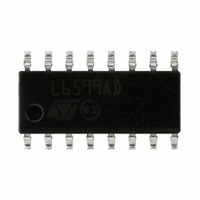L6599ADTR STMicroelectronics, L6599ADTR Datasheet - Page 24

L6599ADTR
Manufacturer Part Number
L6599ADTR
Description
IC RESONANT CONVRTR CTRLR 16SOIC
Manufacturer
STMicroelectronics
Specifications of L6599ADTR
Applications
Resonant Converter Controller
Voltage - Supply
8.85 V ~ 16 V
Current - Supply
3.5mA
Operating Temperature
0°C ~ 105°C
Mounting Type
Surface Mount
Package / Case
16-SOIC (3.9mm Width)
Operating Temperature Classification
Automotive
Mounting
Surface Mount
Pin Count
16
Operating Supply Voltage
8.15 V, 10.7 V, 17 V
Maximum Operating Temperature
+ 150 C
Minimum Operating Temperature
- 40 C
Mounting Style
SMD/SMT
For Use With
497-10542 - BOARD EVAL BASED ON L6599497-8429 - BOARD ADAPTER L6599/STP12NM50N497-5496 - EVAL BOARD FOR L6599
Lead Free Status / RoHS Status
Lead free / RoHS Compliant
Voltage - Input
-
Lead Free Status / Rohs Status
Compliant
Other names
497-8519-2
Available stocks
Company
Part Number
Manufacturer
Quantity
Price
Company:
Part Number:
L6599ADTR
Manufacturer:
U-BLOX
Quantity:
21 000
Part Number:
L6599ADTR
Manufacturer:
ST
Quantity:
20 000
Part Number:
L6599ADTR-2LF
Manufacturer:
ST
Quantity:
20 000
Application information
7.4
24/36
Equation 5
where f
quite empirical and is a compromise between an effective soft-start action and an effective
OCP (see next section). Please refer to the timing diagram of
significant signals during the soft-start phase.
Current sense, OCP and OLP
The resonant half-bridge is essentially voltage-mode controlled; hence a current sense input
will only serve as an overcurrent protection (OCP).
Unlike PWM-controlled converters, where energy flow is controlled by the duty cycle of the
primary switch (or switches), in a resonant half-bridge the duty cycle is fixed and energy flow
is controlled by its switching frequency. This impacts on the way current limitation can be
realized. While in PWM-controlled converters energy flow can be limited simply by
terminating switch conduction beforehand when the sensed current exceeds a preset
threshold (this is commonly now as cycle-by-cycle limitation), in a resonant half-bridge the
switching frequency, that is, its oscillator’s frequency must be increased and this cannot be
done as quickly as turning off a switch: it takes at least the next oscillator cycle to see the
frequency change. This implies that to have an effective increase, able to change the energy
flow significantly, the rate of change of the frequency must be slower than the frequency
itself. This, in turn, implies that cycle-by-cycle limitation is not feasible and that, therefore,
the information on the primary current fed to the current sensing input must be somehow
averaged. Of course, the averaging time must not be too long to prevent the primary current
from reaching too high values.
In
following. The circuit of
might not be negligible, hurting efficiency; the circuit of
virtually lossless and recommended when the efficiency target is very high.
Figure 28
start
is recommended to be at least 4 times f
a couple of current sensing methods are illustrated that will be described in the
Figure 28
R
Doc ID 15308 Rev 5
SS
a is simpler but the dissipation on the sense resistor Rs
=
f
f
RF
start
min
min
−
1
;
C
SS
min
=
. The proposed criterion for C
Figure 28
3
R
⋅
10
SS
−
3
Figure 27
b is more complex but
to see some
L6599A
SS
is













